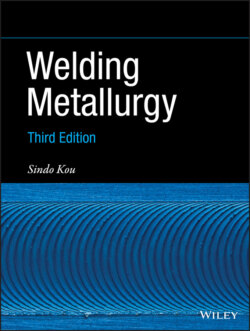Читать книгу Welding Metallurgy - Sindo Kou - Страница 100
3.6 Active Flux GTAW
ОглавлениеThe use of fluxes in GTAW has been found to increase weld penetration in steels and stainless steels dramatically [56–59]. The flux usually consists of oxides and halides, and it is mixed with acetone or the like to form a suspension and painted as a thin coating over the area to be welded. Figure 3.32 shows transverse cross‐sections of bead‐on‐plate welds of 304 stainless steels made by GTAW without and with a commercial active flux called A‐TIG [59]. Two different 304 stainless steels were welded, one with 42 ppm S and the other 140 ppm S. In the case of low S (42 ppm), the weld penetration is clearly deeper with the active flux. In the case of high S (140 ppm S), the effect of the active flux is similar but smaller.
Figure 3.32 Transverse cross‐sections of 304 stainless steel welds: (a) 42 ppm S (low) without flux; (b) 42 ppm S with active flux (A‐TIG); (c) 140 ppm S (high) without flux; (d) 140 ppm S with active flux.
Source: Yu and Kou [59].
Howse and Lucus [56] observed that the arc becomes more constricted when a flux is used. Consequently, they proposed that the deeper penetration is caused by arc constriction and that the vaporized flux constricts the arc by capturing electrons in the cooler outer region of the arc. For the same welding current, the more the arc is constricted, the greater the Lorentz force (F in Figure 3.15c) and deeper penetration.
Tanaka et al. [57], however, proposed that the oxygen from the oxide‐containing flux causes an inward surface flow and hence a deeper penetration. They GTA welded a 304 stainless steel containing little (0.002 wt%) S, with He for shielding and TiO2 as the flux. They observed both an inward surface flow and a significant decrease in the surface tension when the flux is used. As mentioned previously, ∂γ/∂T can become positive and cause inward surface flow in the presence of a surface‐active agent such as oxygen. They observed a steep temperature gradient across the pool surface caused by the inward surface flow. Spectroscopic analysis of the arc showed that the blue luminous plasma appears to be mainly composed of metal vapor (Cr, Fe, etc.) from the weld pool. The steeper temperature gradient across the smaller pool surface suggests a more localized metal evaporation and hence a more constricted arc, which also help increase the penetration.
